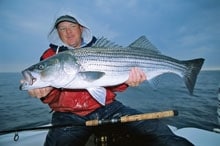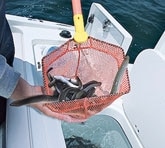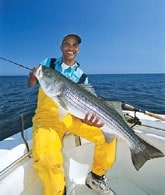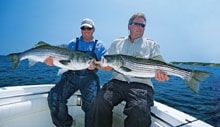
|| |—| || |Eels are a potent striper bait that works from the Northeast to North Carolina. Photo: Ruben Perez| I can’t stand a dishonest fisherman. You know, the type of guy who always claims to catch more or bigger fish than he actually does. As a member of the angling media, it’s my duty to root out these truth-stretchers and expose them for the shameless prevaricators they are. Call me The Lie Detective.
My beat is the charter docks, launch ramps, tackle shops and, more recently, the Internet, where all manner of chat-room scoundrels feel free to post the most outlandish fishing tales. Which brings me to the case of Terry Nugent.
About two years ago I began noticing long, daily posts from this Massachusetts charter captain popping up on two separate fishing forums. According to his outrageous reports, the man was routinely catching 30 to 50 striped bass a day, most of them over 20 pounds, often in broad daylight. Day after day, post after post, brought incredible stories of monster bass taken on eels in water as shallow as five feet. My BS detector was going bonkers.
Undercover Mission
I had to act. Nugent had to be stopped. So, posing as a mild-mannered fishing reporter, I asked if he’d be willing to take me fishing in exchange for a little exposure on his operation. To my surprise, he was only too happy to oblige – as long as I agreed not to reveal the exact locations of his secret honey holes.
One summer day, I met Nugent and his friends Mike Ciolek and Dana Tobey in a deserted parking lot on the Cape Cod Canal at 4 a.m. From there I tailed Nugent and his new 24-foot Hydra-Sports Vector center console onto Cape Cod to a ramp on Falmouth’s Inner Harbor. We quickly dropped the boat in and headed into a dark and foggy Nantucket Sound. Conditions didn’t look promising as we ran through Vineyard Sound, dodging rain squalls and other boats as they popped up on the radar, but when we arrived at our secret destination the sky began to lighten and the rain tapered off.

| |Big stripers like Terry Nugent’s 25-pounder aren’t likely to be hanging with schoolies.| The tide was just starting to move, and Nugent pointed to a faint rip line that was forming some 50 yards downcurrent. He explained that we would be fishing a shallow, rocky reef with a depth of ten to 25 feet. The bass gathered on this particular stretch of bottom every year. Fishing had been slower than usual this year, however, and Nugent surmised that a large concentration of bunker (menhaden) off New Jersey had kept many of the larger fish from moving north. Now that the Jersey bite had dwindled, he was hopeful that a plug of big stripers would be pushing through.
On that note, Tobey and Ciolek began rigging tackle while Nugent opened the transom bait well to reveal a mass of live eels. The well contained about 60 of the slimy “snakes,” all of them quite frisky, which is the way Nugent likes them.
“A lot of guys keep their eels on ice to make them easier to handle,” he explained. “But I always keep mine in the live well. I want them freaking out when they hit the water and start digging for the bottom. That’s what gets a striper’s attention.
“I treat my eels like any kind of live bait,” Nugent continued. “If I dipnet a bunch of eels and one is strong enough to wriggle out, that’s the one I want! I’ll chase that eel all over the boat to get it on my hook.”
Eel Appeal
To say that Nugent believes in the power of eels would be an understatement. He never fishes without some onboard, and prefers to have six to eight dozen if he’s fishing eels exclusively. He buys them by the pound and often keeps them alive at home in large, plastic totes.
“Striped bass can’t resist eels,” says Nugent, who has caught stripers on them from Nauset Inlet on the Cape all the way to Oregon Inlet in North Carolina. “They work everywhere. In fact, I once used an eel to nail a 40-pound fish on the flats in three feet of water. About the only time I have trouble catching fish on eels is when herring dominate in the spring.”
Nugent prefers eels in the 12- to 14-inch range and about as thick around as an average cigar. He rigs them on 7/0 Gamakatsu octopus hooks, which he crimps to three to five feet of 50-pound Seaguar fluorocarbon leader. “I’ve had trouble with knots unraveling with fluoro,” Nugent explains. “That’s why I use crimps. Otherwise, I try to limit the amount of hardware on my rigs, but the fish don’t seem to shy away from the crimps. More importantly, I’ve never had one fail.”
Because Nugent typically fishes in relatively shallow water, he won’t use sinkers. As long as the eel is perky, it will make a beeline for the bottom and swim right into the striper’s lair.
“That eel has all the power it needs to reach bottom,” he says. “When you add an egg sinker to the line, it takes the eel down too fast and makes it look unnatural. As long as the current isn’t too strong and the depth is less than 30 feet or so, sinkers aren’t necessary. In terms of current, I don’t like extremes, so the full and new moons aren’t best. I can generally fish 30 feet of water in slack or mild current, 20 feet of water in moderate current and ten feet in fast current.”
Nugent’s main line is 50-pound Spiderwire Stealth braid, which he spools onto Penn 560 Live Liner spinning reels. The Live Liners allow the fish to pick up the eel and pull line freely off the spool with the bail closed. When it’s time to set the hook, the angler simply flips the drag lever, reels tight and lifts the rod. Drag is set at nine pounds.
Nugent’s rod of choice is the St. Croix TS70MHF, a fast-action graphite stick rated for ten- to 20-pound line. Its medium-heavy power provides leverage for coaxing big stripers away from the bottom, and the seven-foot length helps to sling eels a good distance. The object is to pitch the eel upcurrent, so it reaches bottom over structure or wherever the fish are holding.
Red-Hot Bite
The action on our trip started off slow, but after a bit of moving around on the reef, checking out different spots, Tobey announced that he had a pick-up. He let the fish run with the eel for roughly three seconds, then flipped the drag lever on the Live Liner and set the hook. Five minutes later, a fat, 25-pound striper was lying alongside the boat. Nugent lifted the fish aboard for some photos and carefully released it, as he does with most of the stripers taken on his boat. That’s not to say he’s above keeping a fish or two, but these are usually bass with hook-related injuries.

| |

| |Use the friskiest foot-long eels. (top); Dana Tobey shows off a nice cow. (bottom) Photos: Tom Richardson| Now that we had found the fish, the bites came fast. Using the track plotter, we made repeated drifts over the hot spot and were rewarded with double and triple hookups. All of the fish were over 20 pounds, with the biggest topping out at 35. But the most remarkable thing was that this fantastic action was taking place in broad daylight in calm conditions, without another boat in sight. I began to appreciate Nugent’s secretive ways.
“I have guys who try to charter me for a half-day trip just to find out where I fish,” he later explained. “But I don’t take that bait. I’m not that desperate for business. The thing is, eels work everywhere, so I try to get people to find their own spots. Isn’t that more rewarding anyway?”
If you’re looking for a few good places to try the shallow eel technique in your neighborhood, Nugent offers the following advice: “If I’m shown a half-mile of coastline I’ve never fished before, the first thing I do is look for something different along that shore,” he says. “For example, I’ll focus on places where a river or creek empties out, or any big boulders lying just offshore. I also love steep dropoffs and holes. These are all great places to cast an eel. Lobster pots are good clues too, because they often mark a contour line with fish-attracting structure. The lobstermen have essentially found the fish for me.”
Daytime eeling for stripers is most productive through early summer, with mid-July marking a noticeable dropoff in activity as the fish spend the bright hours in deeper water. However, Nugent points out that the bass will return to the same shallow spots at night during the summer months.
Night eeling continues strong through the fall, and really picks up steam when the southern migration gets underway. In fact, things eventually come full circle, with the shallow rocks and ledges again producing big fish during the daylight hours.
Whether fishing at night or during the day, Nugent gives each spot one or two drifts to produce before moving on. If he uncovers a concentration of small fish, he doesn’t hang around. “If you want to target trophy fish, don’t keep catching schoolies and hope that the big ones are suddenly going to show up. On the other hand, if I’m on a school of good fish, I stay on those fish until the bite stops.”
Slicker by the Dozen

| |Terry Nugent (left) and Mike Ciolek heft a pair of big bass taken on live eels. Photos: Tom Richardson| Fortunately, no such strategy was required on our trip, although a different scenario showed just how determined Nugent is to catch fish – and keep catching them. As the morning progressed, the bite showed no sign of slowing, and after landing around 40 fish someone happened to notice that we were almost out of eels.
It was 11 a.m. Should we call it a day and head for the barn or try to hunt down some more eels? The answer was a no-brainer for Nugent and his crew, and after a few phone calls to find the closest bait shop with eels we were bombing back to the Cape at top speed. Thirty minutes later, Nugent docked the boat, dashed across the street and returned with a trash bag full of squirming eels.
What followed was three hours of the most spectacular striped bass fishing I have ever experienced. Almost every eel we sent down was inhaled by a big striper, and the action did not let up. The fishing was so good that Nugent felt obligated to call a fellow charter captain and clue him in to the bounty. Our drifts lasted a mile or more, and nearly every fish was over 20 pounds. Most were in the 25-pound range, and anything under 20 got laughed at. Remarkably, we only hooked two or three bluefish.
|| |—| |Booking a Trip Capt. Terry Nugent specializes in fishing the waters of Southern New England for trophy striped bass, bluefish and tuna. You can reach him at Riptide Charters, (774) 696-0420 or visit www.riptidecharters.com.| By 4 p.m. we had nearly exhausted our eel supply – again – so we decided to call it quits. It was hard to leave, but after landing well over 100 fish,
I had my fill.
Not Nugent. The next day he was back at it, and the fish were still in the magic spot. Naturally, I read about it on the Internet, but this time I was not among the skeptics. Case closed on this investigation.









